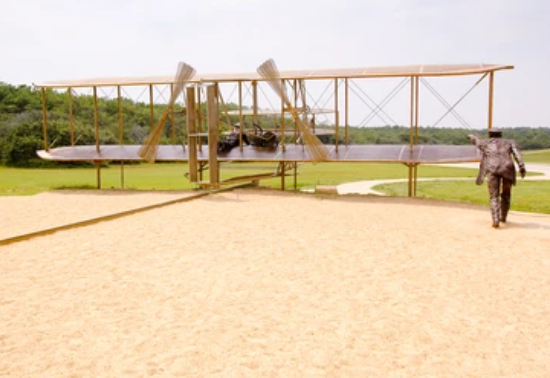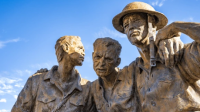The Wright Brothers’ first flight on December 17, 1903, in Kitty Hawk, North Carolina, marked the beginning of the modern aviation era. This historic event, which saw Orville and Wilbur Wright achieve the first controlled, powered flight in a heavier-than-air aircraft, transformed transportation and opened up new possibilities for human exploration. In this article, we will delve into the background, the challenges, and the legacy of the Wright Brothers’ monumental achievement.
Read Also : Was Abraham Lincoln Black? Uncovering the Truth Behind the Rumor
Introduction to the Wright Brothers and Their Invention
The Wright Brothers, Orville and Wilbur, are often credited with inventing the airplane, but their journey to achieving the first successful flight was marked by years of experimentation, innovation, and perseverance. Understanding their background and the context in which they worked provides insight into how they accomplished what many thought was impossible.
Who Were the Wright Brothers?
Orville and Wilbur Wright were born in Dayton, Ohio, to a family that valued education and curiosity. Their father, Milton Wright, was a bishop, and their mother, Susan Koerner Wright, had a knack for mechanics and problem-solving. From a young age, the brothers were fascinated by flight and spent much of their childhood experimenting with kites and other flying toys.
The Wright Brothers were also entrepreneurs. Before turning their attention to flight, they operated a bicycle sales and repair shop, which provided them with both the skills and the financial means to pursue their aviation experiments. Their work with bicycles also influenced their understanding of balance and control, which would later prove crucial in their aircraft designs.
The brothers’ close partnership and shared vision were key to their success. They complemented each other well, with Wilbur often taking the lead in conceptual planning and Orville focusing on the practical aspects of building and testing. Together, they formed a dynamic team that would eventually change the world.
The Early Challenges in Aviation
Before the Wright Brothers’ success, many had attempted to achieve powered flight, but all had failed. The main challenges included developing a reliable engine, creating a controllable aircraft, and achieving sufficient lift to stay airborne. The prevailing belief was that flight might never be possible for heavier-than-air machines.
One of the biggest challenges was controlling an aircraft in flight. Early aviation pioneers struggled to find a way to stabilize and steer their machines, leading to frequent crashes and failures. The Wright Brothers approached this problem systematically, using their knowledge of bicycles to develop a three-axis control system that allowed the pilot to steer the aircraft effectively.
Another significant challenge was finding a suitable location for testing. The Wright Brothers needed a place with strong, steady winds and soft ground to cushion any crashes. After much research, they chose Kitty Hawk, North Carolina, for its favorable conditions. The remote location also allowed them to work in relative privacy, away from the skepticism and ridicule of the public.
The Road to the First Successful Flight
The Wright Brothers’ journey to their first successful flight was marked by years of experimentation and incremental progress. They began with gliders, carefully studying the principles of lift, drag, and control. Each test flight provided valuable data, which they used to refine their designs.
In 1903, after several years of testing gliders, the Wright Brothers felt ready to attempt powered flight. They designed a custom engine and a propeller system, which they mounted on their latest aircraft, the Wright Flyer. The Flyer was made of spruce wood and muslin fabric, with a wingspan of 12.3 meters (40 feet) and a weight of 274 kilograms (605 pounds).
On December 17, 1903, the Wright Brothers made four flights, with Orville piloting the first. The first flight lasted 12 seconds and covered 120 feet. While this may seem modest by today’s standards, it was a groundbreaking achievement at the time. The Wright Brothers had proven that controlled, powered flight was possible, opening the door to the development of modern aviation.
The Significance of December 17, 1903
December 17, 1903, is a date that will forever be remembered in the annals of history. On this day, the Wright Brothers achieved the first successful powered flight in human history. This achievement marked the beginning of a new era, where the skies were no longer the exclusive domain of birds and balloons but open to human exploration.
The significance of this event cannot be overstated. The Wright Brothers’ success proved that flight was not just a dream but a reality that could be achieved with persistence, innovation, and a deep understanding of the principles of aerodynamics. Their flight was the culmination of years of hard work and represented a giant leap forward in human achievement.
The Wright Brothers’ first flight also had profound implications for the future of transportation, warfare, and global connectivity. It laid the foundation for the development of modern aviation, leading to the creation of commercial airlines, military aircraft, and eventually, space exploration.
Public Reaction to the Wright Brothers’ Success
When the Wright Brothers first announced their success, the public reaction was mixed. While some recognized the significance of their achievement, many were skeptical. Newspapers and scientific communities were slow to acknowledge their accomplishment, partly due to the brothers’ secretive nature and the remoteness of Kitty Hawk.
However, as word spread and more demonstrations were conducted, the significance of their achievement became undeniable. By 1908, the Wright Brothers had gained international recognition, with demonstrations in Europe and the United States showcasing the capabilities of their aircraft.
The public’s eventual acceptance of the Wright Brothers’ success marked the beginning of widespread interest in aviation. Their achievement inspired a new generation of inventors, engineers, and aviators who would go on to transform the world through flight.
The Mechanics Behind the First Flight
The Wright Brothers’ first flight was not just a triumph of will and perseverance; it was also a remarkable feat of engineering. Their understanding of aerodynamics, coupled with their innovative design choices, made their success possible.
The Design and Construction of the Wright Flyer
The Wright Flyer was a marvel of early aviation engineering. Built primarily from spruce wood and muslin fabric, it was a lightweight yet sturdy aircraft. The design featured a biplane configuration, with two wings stacked one above the other, which provided the necessary lift while maintaining structural integrity.
One of the key innovations of the Wright Flyer was its control system. The brothers developed a method of wing-warping, which allowed the pilot to twist the wings and control the aircraft’s roll. This was combined with a movable rudder to control yaw and a forward elevator to control pitch. Together, these controls allowed the pilot to maneuver the aircraft in all three axes of flight.
The engine of the Wright Flyer was another crucial component. Designed and built by the Wright Brothers with the help of their mechanic, Charlie Taylor, the engine was a 12-horsepower, four-cylinder design that powered two counter-rotating propellers. This setup provided the thrust needed to achieve flight while maintaining balance and stability.
The Importance of Aerodynamics in the Wright Brothers’ Success
Aerodynamics played a crucial role in the Wright Brothers’ success. Their careful study of lift, drag, and airflow allowed them to design an aircraft that could generate enough lift to overcome gravity while minimizing drag. They conducted extensive wind tunnel tests, experimenting with different wing shapes and angles to find the most efficient design.
The Wright Brothers also paid close attention to the concept of center of pressure, which is the point on a wing where the lift force is concentrated. By adjusting the position of the wings and control surfaces, they were able to ensure that the Flyer remained stable and controllable during flight.
Their understanding of aerodynamics was far ahead of their time and set the stage for future advancements in aircraft design. The principles they discovered and applied continue to be fundamental to modern aeronautical engineering.
The Role of Innovation and Experimentation
Innovation and experimentation were at the heart of the Wright Brothers’ success. They approached the problem of flight with a scientific mindset, conducting countless experiments and making incremental improvements based on the results. Their willingness to learn from failures and refine their designs was key to their eventual success.
The Wright Brothers were also pioneers in the use of data-driven decision-making. They meticulously recorded the results of their tests, analyzing the data to identify patterns and make informed design choices. This methodical approach allowed them to solve complex problems and achieve breakthroughs that others had missed.
Their innovation extended beyond the technical aspects of flight. The Wright Brothers also developed new methods of manufacturing and assembly, creating lightweight, durable components that could withstand the stresses of flight. Their holistic approach to problem-solving set a new standard for engineering excellence.
Challenges Overcome in Achieving Controlled Flight
Achieving controlled flight was one of the biggest challenges faced by the Wright Brothers. While many others had managed to get an aircraft off the ground, controlling it in the air was a different matter entirely. The brothers’ breakthrough came with their development of the three-axis control system, which allowed for precise maneuvering of the aircraft.
They faced numerous challenges in perfecting this system. Early attempts at wing-warping were met with limited success, as the forces generated were often insufficient to counteract the effects of wind and turbulence. The brothers responded by refining the design, experimenting with different control surfaces, and adjusting the aircraft’s center of gravity.
Another challenge was the development of a reliable engine. Early engines were either too heavy or too weak to provide the necessary thrust. The Wright Brothers overcame this by designing their own engine, which was lightweight yet powerful enough to propel the Flyer. This innovation was critical to their success and demonstrated their ability to solve complex engineering problems.
Testing and Refining the Wright Flyer
The Wright Brothers’ approach to testing and refining the Flyer was meticulous and systematic. They conducted hundreds of test flights with gliders before attempting powered flight, carefully observing the aircraft’s performance and making adjustments as needed. Each test provided valuable data that informed their design decisions.
Their testing process was iterative, with each version of the Flyer building on the lessons learned from previous models. They experimented with different wing shapes, control surfaces, and structural materials, constantly seeking to improve the aircraft’s performance.
The final tests leading up to the first flight were particularly critical. The brothers faced numerous setbacks, including mechanical failures and unfavorable weather conditions. However, they persisted, making the necessary adjustments and continuing their experiments until they were confident in the Flyer’s capabilities.
The Legacy of the Wright Brothers’ First Flight
The Wright Brothers’ first flight had a profound impact on the world, ushering in the age of aviation and inspiring generations of inventors and explorers. Their achievement continues to be celebrated as a defining moment in human history.
How the Wright Brothers Changed the World
The Wright Brothers’ first flight revolutionized transportation, making it possible to travel long distances quickly and efficiently. Their invention laid the groundwork for the development of commercial aviation, which has since connected the world in ways previously unimaginable.
In addition to transforming travel, the Wright Brothers’ success also had a significant impact on military strategy. Aircraft quickly became a critical component of modern warfare, providing new capabilities for reconnaissance, combat, and logistics. The brothers’ innovation changed the nature of conflict and influenced the outcome of wars.
The Wright Brothers’ legacy extends beyond aviation. Their approach to problem-solving, characterized by creativity, persistence, and a commitment to experimentation, has inspired countless individuals in fields ranging from engineering to entrepreneurship. Their story serves as a testament to the power of innovation and the human spirit.
The Wright Brothers’ Influence on Modern Aviation
The principles and innovations developed by the Wright Brothers continue to influence modern aviation. Their understanding of aerodynamics, control, and propulsion laid the foundation for the design of modern aircraft. Concepts such as wing-warping have evolved into more sophisticated control systems, but the basic principles remain the same.
The Wright Brothers also set a standard for safety and reliability in aviation. Their meticulous testing and attention to detail have become hallmarks of the industry, ensuring that each new aircraft is rigorously evaluated before being put into service. The legacy of their commitment to quality and safety is evident in the high standards of modern aviation.
Today, the impact of the Wright Brothers can be seen in the vast network of airlines, airports, and air traffic control systems that make global travel possible. Their invention has connected people, cultures, and economies in ways that were once unimaginable, shaping the modern world.
Commemorating the Wright Brothers and Their Achievement
The Wright Brothers’ first flight is commemorated around the world as a milestone in human achievement. The site of their first flight, Kill Devil Hills near Kitty Hawk, North Carolina, is now home to the Wright Brothers National Memorial, which honors their contributions to aviation.
Each year, events are held to celebrate the anniversary of their first flight, drawing enthusiasts, historians, and aviation professionals from around the globe. These commemorations serve as a reminder of the significance of the Wright Brothers’ achievement and the enduring impact of their work.
The Wright Brothers are also remembered through numerous awards, scholarships, and educational programs that bear their name. These initiatives continue to inspire future generations to pursue careers in aviation and engineering, ensuring that their legacy lives on.
The Role of the Wright Brothers in American Innovation
The Wright Brothers are often celebrated as quintessential American innovators, embodying the values of ingenuity, perseverance, and entrepreneurship. Their success is a testament to the power of the American spirit and the potential for individuals to achieve great things through hard work and determination.
Their story is often cited as an example of the American Dream, where two individuals from humble beginnings can achieve extraordinary success through their own efforts. The Wright Brothers’ journey from bicycle mechanics to aviation pioneers is a powerful narrative that continues to resonate with people around the world.
The Wright Brothers’ role in American innovation is also reflected in the broader history of technological progress in the United States. Their success paved the way for future advancements in fields such as space exploration, telecommunications, and information technology, reinforcing America’s position as a leader in global innovation.
Lessons from the Wright Brothers’ Journey
The Wright Brothers’ journey to achieving the first successful flight offers valuable lessons for anyone pursuing innovation or entrepreneurship. Their success was not the result of a single breakthrough but rather a series of small, incremental improvements made over years of hard work and experimentation.
One of the key lessons from their journey is the importance of perseverance. The Wright Brothers faced numerous setbacks and failures, but they never gave up. Instead, they used each failure as an opportunity to learn and improve, ultimately achieving their goal through determination and resilience.
Another important lesson is the value of collaboration. The Wright Brothers’ success was the result of their strong partnership and ability to work together effectively. They complemented each other’s strengths and weaknesses, making them a formidable team. Their story highlights the importance of teamwork and the power of collaboration in achieving great things.
Conclusion: Reflecting on the Wright Brothers’ First Flight
The Wright Brothers’ first flight in 1903 was a monumental achievement that changed the course of history. Their innovation and determination laid the foundation for modern aviation and inspired future generations to explore the possibilities of flight. As we reflect on their legacy, we are reminded of the importance of perseverance, creativity, and collaboration in overcoming challenges and achieving greatness.
The Wright Brothers’ First Flight as a Turning Point in History
The Wright Brothers’ first flight is widely regarded as one of the most significant turning points in human history. It marked the beginning of a new era, where the dream of flight became a reality and opened up new possibilities for exploration, transportation, and communication.
The significance of this event extends beyond the world of aviation. The Wright Brothers’ success demonstrated the power of innovation and the potential for human ingenuity to overcome even the most daunting challenges. Their achievement continues to inspire people around the world to pursue their own dreams and push the boundaries of what is possible.
The Enduring Legacy of the Wright Brothers
The legacy of the Wright Brothers endures to this day, with their contributions to aviation continuing to shape the modern world. Their invention has connected people and cultures across the globe, transforming the way we live, work, and travel. The principles and innovations they developed remain fundamental to the field of aviation, influencing everything from aircraft design to safety standards.
As we look to the future, the Wright Brothers’ legacy serves as a reminder of the importance of innovation and the need to continually push the boundaries of what is possible. Their story is a testament to the power of human creativity and the potential for individuals to make a lasting impact on the world.
Final Thoughts on the Wright Brothers’ Impact
The Wright Brothers’ first flight was more than just a technological achievement; it was a symbol of human potential and the power of perseverance. Their journey from bicycle mechanics to aviation pioneers is a story of determination, innovation, and the relentless pursuit of a dream. As we reflect on their impact, we are reminded of the importance of never giving up, even in the face of seemingly insurmountable challenges.
The Wright Brothers’ success continues to inspire people around the world, encouraging them to explore new ideas, take risks, and pursue their own dreams with the same passion and dedication. Their legacy is a testament to the enduring power of innovation and the potential for individuals to change the world.
Frequently Asked Questions (FAQs)
1. What made the Wright Brothers’ first flight successful?
The success of the Wright Brothers’ first flight was due to a combination of factors, including their innovative design, careful experimentation, and deep understanding of aerodynamics. Their development of the three-axis control system allowed for stable and controlled flight, while their custom-built engine provided the necessary power to achieve lift.
2. How did the Wright Brothers’ first flight influence modern aviation?
The Wright Brothers’ first flight laid the foundation for modern aviation. Their innovations in aircraft control, propulsion, and design continue to influence the development of airplanes today. Their success also sparked widespread interest in aviation, leading to the rapid advancement of the field and the eventual creation of commercial and military aircraft.
3. What challenges did the Wright Brothers face in achieving flight?
The Wright Brothers faced numerous challenges in achieving flight, including the development of a reliable engine, creating a controllable aircraft, and finding a suitable location for testing. They overcame these challenges through persistent experimentation, careful data analysis, and innovative engineering solutions.
4. Why is December 17, 1903, significant in aviation history?
December 17, 1903, is significant in aviation history because it marks the date of the Wright Brothers’ first successful powered flight. This achievement is widely regarded as the birth of modern aviation, as it demonstrated that controlled, sustained flight in a heavier-than-air machine was possible.
5. How are the Wright Brothers remembered today?
The Wright Brothers are remembered as pioneers of aviation and innovators who changed the course of history. Their first flight is commemorated at the Wright Brothers National Memorial, and their legacy continues to inspire future generations through awards, educational programs, and events that celebrate their contributions to aviation.







There are some fascinating deadlines in this article but I don’t know if I see all of them center to heart. There may be some validity but I’ll take hold opinion until I look into it further. Good article , thanks and we would like more! Added to FeedBurner as well
It’s best to take part in a contest for among the finest blogs on the web. I will suggest this site!
You’ve been great to me. Thank you! http://www.hairstylesvip.com
Please provide me with more details on the topic http://www.hairstylesvip.com
Thanks for enabling me to obtain new tips about computer systems. I also have the belief that one of the best ways to help keep your mobile computer in primary condition has been a hard plastic-type case, or maybe shell, that matches over the top of one’s computer. These types of protective gear usually are model distinct since they are manufactured to fit perfectly within the natural outer shell. You can buy them directly from the owner, or from third party sources if they are for your notebook, however not all laptop can have a shell on the market. Just as before, thanks for your suggestions.
Howdy! I could have sworn I’ve visited thos blog before but
after going through some off the articles I realized it’s new
to me. Anyways, I’m certainly happy I stumbled upon it and
I’ll be book-marking it and checking back regularly!